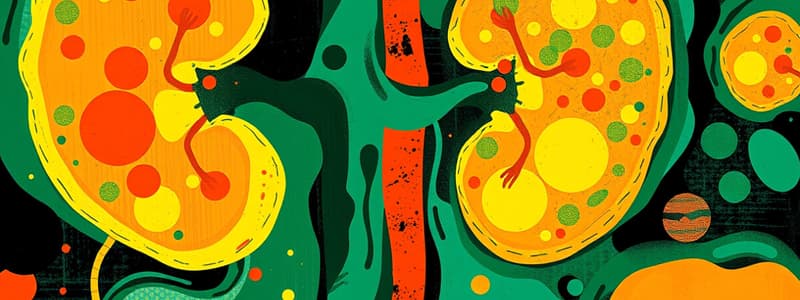Podcast
Questions and Answers
What is the tube from the kidney to the urinary bladder?
What is the tube from the kidney to the urinary bladder?
ureter
What is the microscopic functional unit of the kidney?
What is the microscopic functional unit of the kidney?
nephron
Which of the following does not represent one of the processes in urine formation?
Which of the following does not represent one of the processes in urine formation?
- Glomerular filtration
- Tubular secretion
- Secretion of renin (correct)
- Tubular reabsorption
The external urethral sphincter is composed of involuntary smooth muscle.
The external urethral sphincter is composed of involuntary smooth muscle.
The trigone is a triangular, funnel-like region of the?
The trigone is a triangular, funnel-like region of the?
Juxtamedullary nephrons represent about what percentage of the nephrons?
Juxtamedullary nephrons represent about what percentage of the nephrons?
Which structure includes the glomerulus and the glomerular capsule?
Which structure includes the glomerulus and the glomerular capsule?
Match the structures of the kidney with their correct descriptions:
Match the structures of the kidney with their correct descriptions:
Glomerular filtrate collects in the __________ before entering the first portion of the renal tubule, called the __________.
Glomerular filtrate collects in the __________ before entering the first portion of the renal tubule, called the __________.
Which blood vessel has the larger diameter: afferent arteriole or efferent arteriole?
Which blood vessel has the larger diameter: afferent arteriole or efferent arteriole?
What is the functional significance of the diameter difference between the afferent and efferent arterioles?
What is the functional significance of the diameter difference between the afferent and efferent arterioles?
Identify the capillary bed involved in filtering blood in the nephron.
Identify the capillary bed involved in filtering blood in the nephron.
A blockage in the __________ would prevent filtrate from reaching the collecting duct.
A blockage in the __________ would prevent filtrate from reaching the collecting duct.
Ninety percent of nephrons are classified as __________ nephrons.
Ninety percent of nephrons are classified as __________ nephrons.
What type of nephrons have very long loops?
What type of nephrons have very long loops?
Which of the following is NOT a function of the kidney?
Which of the following is NOT a function of the kidney?
Flashcards are hidden until you start studying
Study Notes
Urinary System Overview
- Pre-lab: Preparation stage before conducting laboratory experiments on the urinary system.
- Ureters: Tubes that transport urine from the kidneys to the urinary bladder.
- Urethra: Tube that conveys urine out of the body; exits from the urinary bladder.
Kidney Structure and Function
- Nephron: The microscopic functional unit of the kidney, crucial for urine formation.
- Cortical Nephrons: Comprise about 85% of total nephrons; mainly located in the renal cortex.
- Juxtamedullary Nephrons: Represent about 15% of nephrons; have long loops extending deep into the medulla.
- Renal Corpuscle: Composed of the glomerulus (capillary network) and the glomerular capsule, responsible for filtration.
Urine Formation Processes
- Urine is formed through three main processes:
- Glomerular Filtration: Initial filtering of blood to form filtrate.
- Tubular Reabsorption: Reabsorption of water and solutes back into the blood.
- Tubular Secretion: Additional waste products secreted into the filtrate.
- Secretion of Renin: Not a process of urine formation but rather involved in blood pressure regulation.
Anatomy of the Kidney
- Renal Pyramid: Conical tissue in renal medulla; participates in urine collection.
- Calyces: Extensions of renal pelvis that collect urine from renal pyramids; consist of minor and major calyces.
- Renal Pelvis: Funnel-shaped structure that collects urine from the calyces and directs it into the ureter.
- Renal Hilum: Medial depression allowing entrance of blood vessels, nerves, and ureters into the kidney.
Urethral Structure and Function
- External Urethral Sphincter: Composed of voluntary skeletal muscle; aids in urine retention and release.
- Trigon: Triangular area in the bladder floor; marked by the openings of the ureters and the urethra.
Blood Flow in the Kidney
- Afferent Arteriole: Carries blood towards the glomerulus; has a larger diameter compared to the efferent arteriole.
- Efferent Arteriole: Carries blood away from the glomerulus; its smaller diameter creates higher blood pressure in the glomerulus for filtration.
- Peritubular Capillaries: Surround nephron tubules and facilitate the exchange of substances between blood and filtrate.
Microscopic Anatomy
- Podocytes: Specialized cells in the visceral layer of the glomerular capsule; crucial for filtration.
- Microvilli: Highly developed in proximal convoluted tubules for increased surface area and absorption.
Clinical Relevance
- A blockage in the distal tubule can prevent filtrate from reaching the collecting duct, impacting urine formation.
- A virus targeting podocytes can damage the glomerular capsule, disrupting filtration.
Summary
- The kidney plays an essential role in regulating blood pressure, pH, and electrolyte balance, besides filtering and producing urine. Understanding its structure and functions, as well as the pathways involved in urine flow, is critical for comprehending renal physiology.
Studying That Suits You
Use AI to generate personalized quizzes and flashcards to suit your learning preferences.



